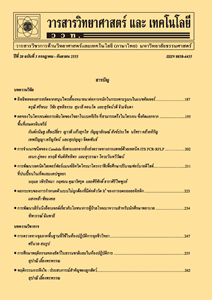การศึกษาพันธุกรรมของตาลโตนด (Borassus flabellifer) ในภาคกลางของประเทศไทยโดยใช้เครื่องหมายเอแอฟแอลพี
Main Article Content
Abstract
Abstract
Asian Palmyra palm (Borassus flabellifer), an important plant for local economic, can be found throughout Thailand. It has a very long lifespan, and its reproduction starts at 12-15 years of age. Asian Palmyra palm is dioecious, in which male and female plant are undistinguishable by morphology. The molecular data of Asian Palmyra palm in Thailand are currently limited to only RAPD and ISSR. Thus, this research aimed to apply the AFLP marker for studying genetic diversity of Asian Palmyra palm in the central Thailand. Twelve markers showed 66 polymorphic loci in 150 accessions. Evaluation of these loci indicated lower genetic variation values. A dendrogram was constructed based on UPGMA method, and PCA analysis showed that Asian Palmyra palms from the central Thailand have a very narrow genetic distant, with high similarity coefficient values (>0.8). The data obtained from this work are consistent with the previous studies using samples from Song kha and Petchburi provinces that the Asian Palmyra palms have a very low genetic diversity.
Keywords: Asian Palmyra palm; AFLP; diversity; dendrogram
Article Details
References
[2] George, J. and Karun, A., 2011, Marker assisted detection of seed sex ratio in palmyrah palm (Borassus flabellifer L.), Curr. Sci. (Bangalore) 100: 922-925.
[3] Morton, J.F., 1988; Notes on distribution, propagation, and products of Borassus Palms (Arecaceae), Econ. Bot. 42: 420-41.
[4] Saputro, A.D., van de Walle, D., Aidoo, R. P., Mensah, M.A., Delbaere, C., De Clercq, N, van Durme, J. and Dewettinck, K., 2017, Quality attributes of dark chocolates formulated with palm sap-based sugar as nutritious and natural alternative sweetener, Eur. Food Res. Technol. 243: 177-191.
[5] George, J., Karun, A., Manimekalai, R, Rajesh, M. and Remya, P., 2007, Identification of RAPD markers linked to sex determination in palmyrah (Borassus flabellifer L.), Curr. Sci. 93: 1075-1077.
[6] Ruttajorn, K., 2006, Sex Identifying in Palmyra Palm (Borassus fiabellifer L.) Using Botanical Characteristics and Amplified Fragment Length Polymorphism (AFLP) Marker, M.S. Thesis, Thaksin University, Songkhla, 74 p.
[7] George, J., Venkataramana, K., Nainar, P., Rajesh, M. and Karun, A., 2016, Evaluation of molecular diversity of ex situ conserved germplasm of palmyrah (Borassus flabellifer L.) accessions using RAPD markers, J. Plant. Crops 44: 96-102.
[8] Promkaew, R., 2006, Study on Genetic Relationship in Palmyra Palm (Borassus flabellifer Linn.) Populations by RAPD (Random Amplified Polymorphic DNA) and ISSR (Inter Simple Sequence), M.S. Thesis, Prince of Songkla University, Songkla, 95 p.
[9] Vos, P., Hogers, R., Bleeker, M., Reijans, M., Lee, Tvd., Hornes, M., Friters, A., Pot, J., Paleman, J. and Kuiper, M., 1995; AFLP: A new technique for DNA fingerprinting, Nucl. Acids Res. 23: 4407-4414.
[10] Gawel, N.L.A. and Jarnet, R.L., 1991, Modified CTAB DNA extraction procedure of Musa and Lpomoea, Plant Mol. Bio. Rep. 9: 262-266.
[11] Benbouza, H., Jacquemin, J.M., Baudoin, J.P. and Mergeai, G., 2006, Optimization of a reliable, fast, cheap and sensitive silver staining method to detect SSR markers in polyacrylamide gels, Biotechnol. Agron. Soc. Environ. 10: 77-81.
[12] Kimura, M. and Crow, J.F., 1964, The number of alleles that can be maintained in a finite population, Genetics 49: 725-738.
[13] Nei, M., 1973, Analysis of gene diversity in subdivided populations, Proc. Nat. Acad. Sci. USA. 70: 3321-3323.
[14] Stebbins, G.L. and Lewontin, R., 1972, Comparative evolution at the levels of molecules, organisms and populations, Proceedings of the Sixth Berkeley Symposium on Mathematical Statistics and Probability, Berkeley and Los Angeles, 5: 23-42.
[15] Yeh, F.C., Yang, R.C. and Boyle, T., 1999, POPGENE version 1.32: Microsoft Windows – Based Freeware for Population Genetic Analysis, Quick User Guide, Center for International Forestry Research, University of Alberta, Edmonton, Alberta, Canada.
[16] Lynch, M. and Walsh, B., 1998, Genetics and Analysis of Quantitative Traits, Sinauer Associates Inc., Sunderland.
[17] Rohlf, J.F., 1998, Numerical Taxonomy and Multivariate Analysis System, Exeter Software, Setauket, New York.
[18] Sneath, P.H.A. and Sokal, R.R., 1973, Numerical Taxonomy, The Principles and Practice of Numerical Classification, W.H. Freeman, San Francisco.
[19] Staub, J.E., Box, J., Meglic, V., Horejsi, T.F. and McCreight, J.D., 1997, Comparison of isozyme and random amplified polymorphic DNA data for determining intraspecific variation in Cucumis, Genet. Res. Crop. Evol. 44: 257-269.
[20] Darroch, J.N. and Mosimann, J.E., 1985, Canonical and Principal Components of Shape, Biometrika, 241-252 p.
[21] Baraket, G., Chatti, K., Saddoud, O., Mars, M., Marrakchi, M., Trifi, M. and Salhi-Hannachi, A., 2009. Genetic analysis of Tunisian fig (Ficus carica L.) cultivars using amplified fragment length polymorphism (AFLP) markers, Sci. Hort. 120: 487-492.
[22] Perera, L., Russell, J.R., Provan, J., McNicol, J.W. and Powell, W., 1998, Evaluating genetic relationships between indigenous coconut (Cocos nucifera L.) accessions from Sri Lanka by AFLP profiling, Theor. Appl. Genet. 96: 545-550.
[23] Purba, A.R., Noyer, J.L., Baudouin, L., Perrier, X., Hamon, S. and Lagoda, P.J.L., 2000, A new aspect of genetic diversity of Indonesian oil palm (Elaeis guineensis Jacq.) revealed by isoenzyme and AFLP markers and its consequences for breeding, Theor. Appl. Genet. 101: 956-961.
[24] Ponnuswami, V., 2010, Genetic diversity in palmyrah genotypes using morphological and molecular markers, Elec. J. Plant Breed. 1: 556-567.
[25] Raju, D.C. and Reji, J.V., 2015, Genetic diversity analysis in palmyra palms using RAPD markers, Int. J. Pharm. Bio. Sci. 6: 244-250.

